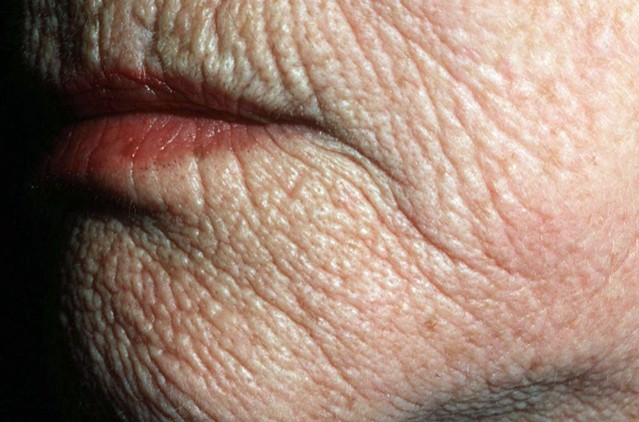SOLAR ELASTOSIS

Definition: Solar Elastosis is degeneration of elastic, dermal connective tissue in sun exposed skin. This usually manifests in deep wrinkles. [1]
Other Names: Sun damage, photoaging
Causes
Sun exposure, even small amounts, is responsible for most of the skin damage associated with aging. Damage to the skin accumulates slowly over time and often results in cosmetic deficiencies but some effects (for example skin cancer) are more serious.
The sun’s ultraviolet radiation breaks down the skin’s connective tissue, which consists of collagen and elastin fibers. These fibers are located in the deeper layer of skin (dermis). Without the supportive connective tissue, the skin loses its strength and flexibility. This condition, known as solar elastosis, is characterized by vertical creases, deep wrinkles, and loose or sagging skin. [2]
The signs of aging usually become evident as a woman enters her late 30’s and 40’s. Loss of the hormone estrogen is reflected by skin changes, such as wrinkles. The relationship between estrogen and the skin is complex and connected to the number of estrogen receptors in the skin, levels of estrogen and levels of other circulating hormones. With depletion of ozone layer and popularity of tanning beds many people are increasingly exposed to the harmful UV rays of the sun. Skin ageing is becoming more visible with signs of damage becoming evident in younger individuals.
Treatment
The best treatment of solar elastosis is prevention. You can prevent sunburn and the related skin conditions by protecting your skin whenever you’re outdoors by wearing a hot, protective clothing, and sunscreen with SPF of at least 30. However, if you do see signs of solar elastosis, there are antiaging skin care products and treatment available. These include:
Dermal fillers and Neurotoxin Injectables –There is a wide variety of wrinkle-reducing dermal fillers (such as Restylane, Juvederm, and Perlane) and neurotoxin injectables (such as Botox and Dysport). Each has its own benefits and limitations. The main differences between products come from the product’s primary active ingredient. Of course, the best thing to do if you’re considering a dermal filler or neurotoxin injectable treatment is to schedule a consultation with a knowledgeable physician. [3]
Ablative Laser Skin Resurfacing – Sometimes called a “laser peel,” ablative laser skin resurfacing can be very effective in minimizing or sometimes even erasing fine lines and wrinkles. The procedure essentially vaporizes (ablates) targeted areas of the skin’s top layer, or epidermis. The new skin that forms in its place appears tighter, smoother, and more even in both tone and texture. Some ablative lasers also work in deeper layers of the skin to stimulate the production of new collagen. Two basic types of lasers are used for skin resurfacing: C02 lasers and erbium lasers. Carbon dioxide (CO2) lasers have been around for many years for the treatment of deep wrinkles and other cosmetic skin problems. They deliver short bursts of very targeted high-energy laser light. Erbium lasers are designed to treat superficial and moderately deep lines and wrinkles. Side effects are often less than with CO2 lasers, and recovery time also tends to be slightly shorter. [3]
Radiofrequency Rejuvenation – The main goal of radiofrequency skin rejuvenation is to stimulate collagen production deep within the skin (the dermis and cutaneous layers) while leaving the skin’s surface (the epidermis) relatively untouched. [3] This can be especially useful for skin tightening.
Anti-Wrinkle Creams – Many of the anti-wrinkle creams and lotions reduce the appearance of facial lines and wrinkles very marginally and often do not results in the wrinkle reduction patients expect. This is because they don’t contain the kinds and/or the amounts of active ingredients that can truly have an effect on sagging skin. Some of these products can, however, help remove dead cells from your skin (exfoliation). [3] This will often result in brighter, slightly younger-looking skin due to the removals of dead cells and debris from the surface of skin.
The only ingredients recognized by the U.S. Food and Drug Administration (FDA) as having potential to reduce wrinkling are derivatives of vitamin A known as retinoid. The most commonly used retinoid is tretinoin. There are some other products, available only through physicians (but not requiring a prescription), with active ingredients strong enough to penetrate the skin and perhaps change its physiology such as AHA. Ask your physician about these medical skin care products (moisturizers, toners, ex-foliants, antioxidants, and sunscreens). [3]
References
- Solar elastosis. http://medical-dictionary.thefreedictionary.com/solar+elastosis
- Slide Show, Sun Damage. The Mayo Clinic. http://www.mayoclinic.com/health/sun-damage/SN00021&slide=7.


